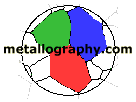
GRAlN SlZE DlSTRlBUTlONSThe previous examples of grain structures were of equiaxed grains with a uniform size distribution, that is, if a frequency histogram is plotted of the grain diameters, intercept lengths, or areas, a single peak is observed which will be symmetrical in shape if the dimension scale is logarithmic. However, there are occasions where more complex distributions are observed, often in specimens where recrystallization is incomplete, or at the onset of rapid grain growth. Test Methods E 112 is not well suited for such specimens--Methods E 930 or E 1181 must be used, usually the latter. As an illustration, Figure A (the figures for this sidebar are in the margins) shows the microstructure of an experimental hot work tool steel that was austenitized at 1975 degrees F ; grain growth was very rapid at slightly higher temperatures. Etching revealed the prior-austenite grain boundaries which, except for one very large grain, are from a single distribution. In measuring the grain size of this specimen, we could determine the grain size of this one very large "rogue" grain by Methods E 930 and the rest oi the grains using Test Methods E 112. A somewhat similar example is given in Figure B, which shows the onset of grain growth in A286. These are twinned austenite grains revealed by a grain contrast etch, rather than a flat etch as in Figure A. We could measure the largest of these grains by Methods E 930 and the fine region by Test Methods E 112, or we could use the approaches in Methods E 1181 for the entire structure. Sometimes the duplex nature of the grain size distribution is highly segregated, in other cases the two distritbutions are intermixed. Figure C shows a relatively well mixed bimodal distribution of grain sizes. This is a superalloy specimen with a flat etch containing annnealing twins. Figure D, on the other hand, shows an extremely segregated example of a duplex condition. Note that grain growth has occurred at two locations along the surface of this low-carbon steel specimen. Another segregated form of a duplex condition is the so-called "necklace" type, as shown in Figures E and F. Both are highly alloyed stainless steels that have not been fully recrystallized. The fine recrystallized grains surround the large non-recrystallized grains. The main difference between the two examples is the pronounced elongation of the non-recrystallized grains in Figure F due to the difference in sectioning plane orientation, transverse vs. longitudinal, for the two. The amounts of the fine and coarse grains can vary considerably. Obviously, the percentage of the number of grains of each type will be much different than the area or volume percentage of each type. Figure G shows a more equal area percentage of fine and coarse grains in a nickel-base superalloy. In some cases, the different grain size distributions may be in a layered or banded manner due to the influence of segregation. Figure H shows such a pattern in ferritic stainless steel plate specimen. Note the very long, thin non-recrystallized grain. The grain size of such specimens should not be described by a single average value, as it is quite possible that there will not be any actual grains of that size in the specimen; or, the average chosen may be in one of the tails of the two grain size distributions. The best approach is to determine the area percentage of each grain size distribution and the average grain size of each distribution in specimens with a duplex or bimodal grain size distribution, as described in Methods E 1181. |
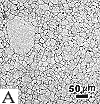
|
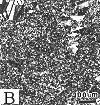
|
|

|
|
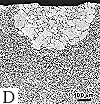
|
|
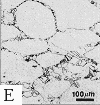
|
|
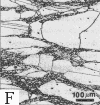
|
|
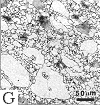
|
|
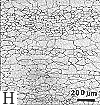
|
[Back to grain article] |
[Home] |
[Search] |
[Vendors] |
|---|